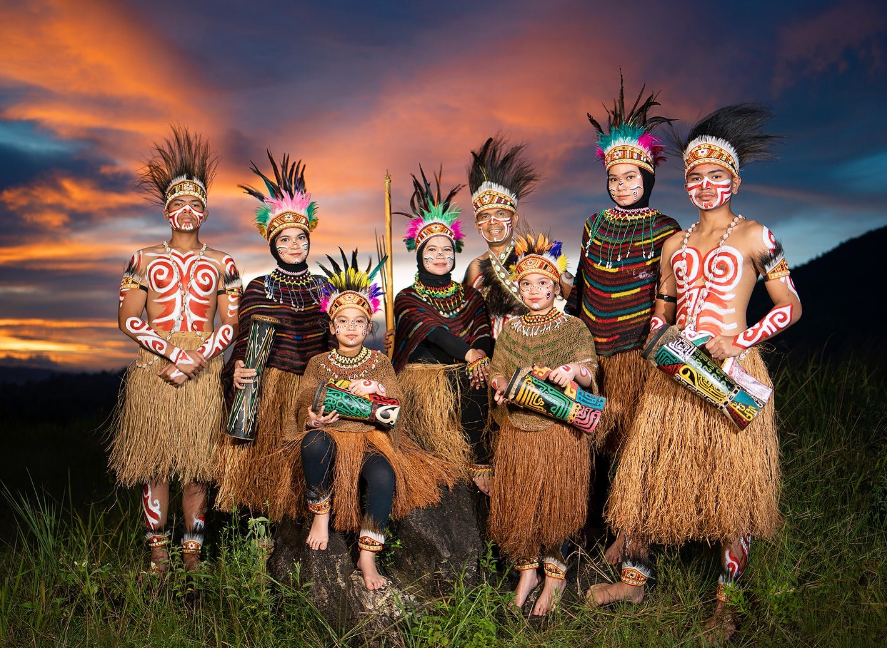PapuaAround.com – The “Baju Kurung Papua” has recently emerged as a topic of heated debate, particularly in the context of cultural representation and appropriation. Despite its growing popularity in some circles, this traditional attire has sparked criticism for its portrayal and use outside its cultural origins. Critics argue that the widespread commercialization and adaptation of the Baju Kurung Papua, especially in non-Papuan regions, distort its cultural significance and contribute to a broader issue of cultural misappropriation.
The Baju Kurung Papua is more than just a piece of clothing; it is a symbol deeply embedded in the cultural heritage of Papua. Traditionally, this attire has been worn by Papuan women during important ceremonies and rituals, symbolizing respect, identity, and connection to their ancestral roots. The design and patterns of the Baju Kurung are often unique to specific tribes, reflecting the rich diversity of Papua’s indigenous cultures. Therefore, the careless use and adaptation of this attire by those outside the Papuan community are seen as a direct affront to its cultural value.
In recent years, the Baju Kurung Papua has been commercialized, often stripped of its cultural context and sold as a fashionable garment in markets far removed from Papua. This commercialization has been criticized for reducing a culturally significant garment to a mere fashion statement. Critics argue that this not only undermines the traditional values associated with the attire but also perpetuates a form of cultural exploitation. As one cultural expert noted, “The Baju Kurung Papua is not just a dress; it carries the identity and history of our people. Its misuse in fashion trivializes our culture.”
Moreover, the adaptation of the Baju Kurung Papua often involves changes to its original design, leading to a misrepresentation of its true cultural meaning. Designers outside of Papua may alter the patterns, colors, and styles to suit broader market trends, thereby diluting its cultural authenticity. This practice has been condemned by many as an example of how indigenous cultures are often appropriated and distorted to serve commercial interests.
The issue of cultural appropriation is at the heart of the controversy surrounding the Baju Kurung Papua. Cultural appropriation occurs when elements of a minority culture are adopted by members of a dominant culture without proper understanding or respect for their significance. In the case of the Baju Kurung Papua, its adoption by non-Papuan designers and consumers is viewed by many as a blatant act of cultural appropriation.
Baca juga: Get to know Papua Traditional Clothing: Sali, Yokal, and Koteka
This appropriation has serious implications. For one, it can lead to the erasure of the original cultural meanings attached to the attire. As more people adopt the Baju Kurung Papua without understanding its cultural roots, the attire risks becoming detached from its original context, losing its significance in the process. This not only disrespects the Papuan community but also contributes to the broader issue of cultural homogenization, where unique cultural identities are diminished in favor of mainstream trends.
Furthermore, the commercialization of the Baju Kurung Papua often results in financial gain for those outside the Papuan community, while the original creators and custodians of the culture see little to no benefit. This economic exploitation is yet another layer of injustice, exacerbating the already existing power imbalances between dominant and marginalized cultures.
The growing concern over the cultural misrepresentation of the Baju Kurung Papua has led to a wave of protests from various cultural and indigenous rights groups. These groups are calling for greater recognition of the cultural significance of the attire and for measures to protect it from further appropriation.
One prominent activist stated, “It’s time we stop treating indigenous cultures as if they are there for the taking. The Baju Kurung Papua is part of our identity, and its commercialization without our consent is a violation of our rights.” This sentiment is shared by many within the Papuan community, who feel that their culture is being commodified and exploited for the benefit of outsiders.
In response to these concerns, some have called for stricter regulations on the use of indigenous cultural symbols in fashion and other commercial ventures. Such regulations could include requiring designers to seek permission from the communities whose cultural symbols they wish to use or ensuring that a portion of the profits generated from such designs goes back to the original cultural custodians.
Education plays a crucial role in addressing the issue of cultural misappropriation. By raising awareness about the significance of indigenous cultures and the importance of respecting their symbols, society can foster a greater appreciation for cultural diversity. This includes educating both consumers and designers about the potential harm of cultural appropriation and encouraging them to engage with indigenous cultures in a more respectful and meaningful way.
Furthermore, educational initiatives should also aim to empower indigenous communities by providing them with the tools and resources needed to protect and promote their cultural heritage. This could involve supporting indigenous-led businesses that produce and sell traditional attire like the Baju Kurung Papua, ensuring that the cultural and economic benefits of these products remain within the community.
The controversy surrounding the Baju Kurung Papua serves as a stark reminder of the broader issues of cultural appropriation and misrepresentation. While the commercialization of indigenous cultural symbols may bring them into the global spotlight, it often does so at the expense of their original meanings and the communities to which they belong. To address this, there needs to be a concerted effort to protect indigenous cultures from exploitation and to ensure that their cultural symbols are respected and preserved. Without such efforts, the rich cultural heritage embodied in garments like the Baju Kurung Papua risks being lost to the forces of commercialization and cultural homogenization.

